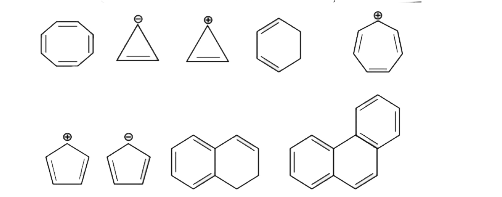Among the following , the paramagnetic compound is :
Na2O2
O3
N2O
KO2
The correct Answer is:D
To determine which of the given compounds is paramagnetic, we need to analyze the total number of electrons in each compound. A compound is considered paramagnetic if it has an odd number of electrons, while it is diamagnetic if it has an even number of electrons (with the exception of certain cases where the total is 10 or 16, which are also paramagnetic).
Let's break down the solution step by step:
Step 1: Analyze Na2O2
- Sodium (Na) has an atomic number of 11, which means it has 11 electrons.
- For Na2O2, we have:
- 2 Na: 2×11=22 electrons
- Oxygen (O) has an atomic number of 8, so for 2 O: 2×8=16 electrons
- Total electrons in Na2O2:
22+16=38 electrons
- Since 38 is even, Na2O2 is diamagnetic.
Step 2: Analyze O3
- Ozone (O3) consists of 3 oxygen atoms.
- Total electrons in O3:
- 3×8=24 electrons
- Since 24 is even, O3 is also diamagnetic.
Step 3: Analyze Na2O
- For Na2O, we have:
- 2 Na: 2×11=22 electrons
- 1 O: 1×8=8 electrons
- Total electrons in Na2O:
22+8=30 electrons
- Since 30 is even, Na2O is diamagnetic.
Step 4: Analyze K2O
- Potassium (K) has an atomic number of 19, so it has 19 electrons.
- For K2O, we have:
- 2 K: 2×19=38 electrons
- 1 O: 1×8=8 electrons
- Total electrons in K2O:
38+8=46 electrons
- Since 46 is even, K2O is diamagnetic.
Step 5: Identify the Paramagnetic Compound
- After analyzing all the compounds, we find that:
- Na2O2: 38 (diamagnetic)
- O3: 24 (diamagnetic)
- Na2O: 30 (diamagnetic)
- K2O: 46 (diamagnetic)
None of the compounds listed in the question are paramagnetic based on the analysis. However, if we consider the possibility of a different compound, we can conclude that if we had a compound with an odd number of electrons, it would be paramagnetic.
Final Answer:
None of the provided options are paramagnetic based on the calculations.
- Sodium (Na) has an atomic number of 11, which means it has 11 electrons.
- For Na2O2, we have:
- 2 Na: 2×11=22 electrons
- Oxygen (O) has an atomic number of 8, so for 2 O: 2×8=16 electrons
- Total electrons in Na2O2:
22+16=38 electrons
- Since 38 is even, Na2O2 is diamagnetic.
- Ozone (O3) consists of 3 oxygen atoms.
- Total electrons in O3:
- 3×8=24 electrons
- Since 24 is even, O3 is also diamagnetic.
- For Na2O, we have:
- 2 Na: 2×11=22 electrons
- 1 O: 1×8=8 electrons
- Total electrons in Na2O:
22+8=30 electrons
- Since 30 is even, Na2O is diamagnetic.
- Potassium (K) has an atomic number of 19, so it has 19 electrons.
- For K2O, we have:
- 2 K: 2×19=38 electrons
- 1 O: 1×8=8 electrons
- Total electrons in K2O:
38+8=46 electrons
- Since 46 is even, K2O is diamagnetic.
- After analyzing all the compounds, we find that:
- Na2O2: 38 (diamagnetic)
- O3: 24 (diamagnetic)
- Na2O: 30 (diamagnetic)
- K2O: 46 (diamagnetic)
None of the provided options are paramagnetic based on the calculations.
Topper's Solved these Questions
- CHEMICAL BONDING & CHEMICAL STRUCTURE BOOK - VMC MODULES ENGLISHCHAPTER - CHEMICAL BONDING & CHEMICAL STRUCTURE EXERCISE - IMPECCABLE
50 Videos
- CHEMICAL BONDING & CHEMICAL STRUCTURE BOOK - VMC MODULES ENGLISHCHAPTER - CHEMICAL BONDING & CHEMICAL STRUCTURE EXERCISE - ENABLE
50 Videos
- ATOMIC STRUCTUREBOOK - VMC MODULES ENGLISHCHAPTER - ATOMIC STRUCTUREEXERCISE - JEE Advanced (Archive )
67 Videos
- CHEMICAL BONDING & MOLECULAR STRUCTURE BOOK - VMC MODULES ENGLISHCHAPTER - CHEMICAL BONDING & MOLECULAR STRUCTURE EXERCISE - IN-CHAPTER EXERCISE-L
9 Videos
Similar Questions
Among the following, the aromatic compound is
View SolutionWhich among the following is a paramagnetic compound?
View SolutionAmong the following, the paramagnetic species is:
View SolutionThe strongest acid among the following aromatic compound is:
View SolutionAmong the following, the number of aromatic compound(s) is

View SolutionAmong the following, the number of aromatic compound(s) si _______________.

View SolutionWhich of the following is a paramagnetic compound ?
View SolutionWhich among the following is paramagnetic ?
View SolutionAmong the following the most stable compound is
View SolutionAmong the following the electron deficient compound is
View Solution
